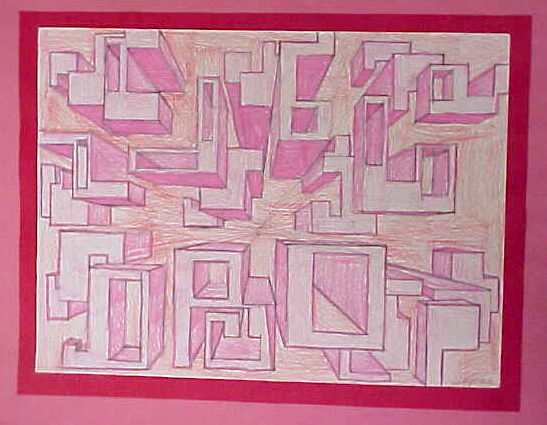
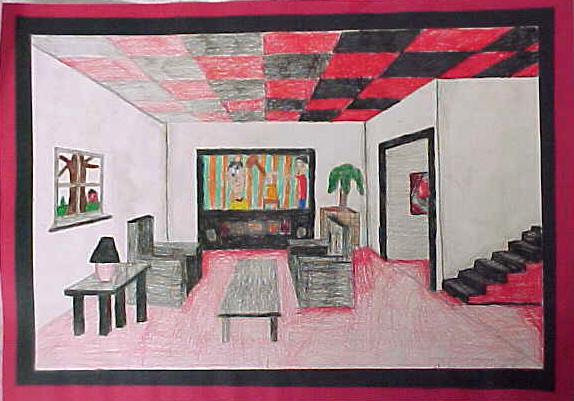
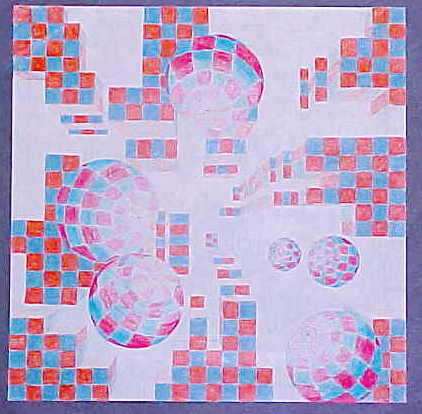
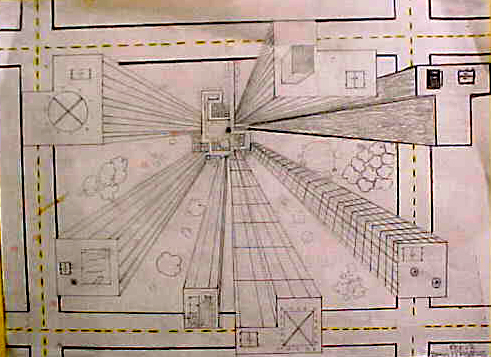
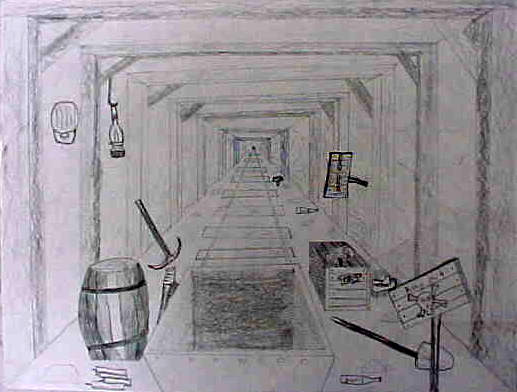
| Links to sites on Drawing With Perspective |
| http://mathforum.org/sum95/math_and/perspective/perspect.html |
| http://www.olejarz.com/arted/perspective/ |
| http://www.homeschoolarts.com/per-l1-1.htm |
|
MAJOR UNITS OF STUDY |
|
| PERSPECTIVE | CLICK |
| COLOR | CLICK |
| STILL LIFE | CLICK |
| ART HISTORY | CLICK |
| WEB QUEST | CLICK |
| HOME | 8TH SEM | 8TH FULL YEAR |
|
PERSPECTIVE VOCABULARY |
| Perspective: The use of size variation,
overlap, and converging lines to create the illusion of 3D space (depth)
on a 2D surface.
Line: The path made by a moving point. Vertical: Up and down. Horizontal: Side to Side. Horizon Line (Eye Level Line): A line parallel to the drawers’ eyes. Parallel: Two or more straight lines always the same distance apart. Perpendicular: Two lines that meet at a right angle. Right Angle: 90-degree angle.Vanishing Point: The point where converging lines meet. Guidelines: Lines that go to the vanishing point. (Converging) Parallel Perspective: Also called one point perspective because there is one V.P. and objects are parallel to the picture plane. Space: The area above, behind, around in a piece of art, or the implied effect of space in a drawing.
|
|
STUDENT EXAMPLES |
| COLOR VOCABULARY
"Color, an element of art, is the visual effect that is caused by the spectral composition of the light emitted, transmitted, or reflected by objects ."
Hue : The specific name of a color, such as "red".Intensity: The strength or weakness of the color. This is also called the "saturation" or "chroma".
Tint: A lighter hue produced by mixing white with a color. Shade: A darker color produced by adding black to a color. Primary Colors: Red, yellow, and blue are the primary colors. Secondary Colors: Orange, green and violet are the secondary colors. Warm Colors: The colors on the "infared" side of the spectrum. They would include the yellows, oranges, and reds. Cool Colors: The colors on the "ultraviolet" side of the spectrum. They would include blues, greens and violets. Complimentary Colors: Colors that are opposite each other on the color wheel. Analogous Colors: Colors that are next to each other on the color wheel. Monochromatic: One color plus the addition of black and white.
|
|
|
|
||||
|
|
|
||||
|
|
|
| Still-life Vocabulary
Still-life: The subject of an art work is inanimate objects. (flowers, fruit etc.) Shadow: A darker area on an form where the light doesn’t reach. Cast shadow: A shadow that is caused by an object blocking the light source. Highlight: a light spot on a form caused by the light directly hitting an object and bouncing off. Composition: the arrangement of the objects and elements in a piece of art. Forms: Three dimensional objects. Negative space: The empty space in a work of art. Positive space: The filled space in a work of art. Center of interest: The area or object that attracts the eye in a work of art. Ellipse: A circle which is moving away from you in space. Value: The element of art that refers to the lightness or darkness of a color or media. Value scale: a chart that shows changing values from dark to light.
|
|
|
|
||||
|
|
|
||||
|